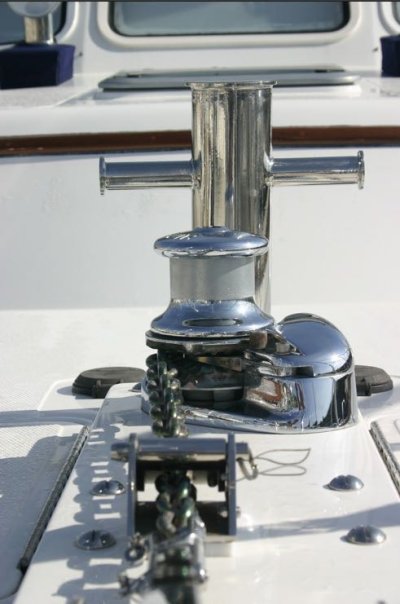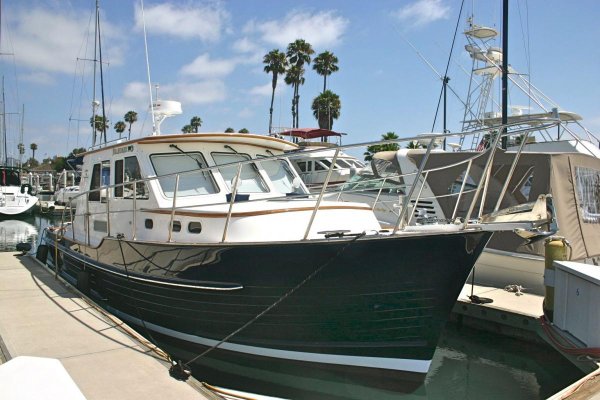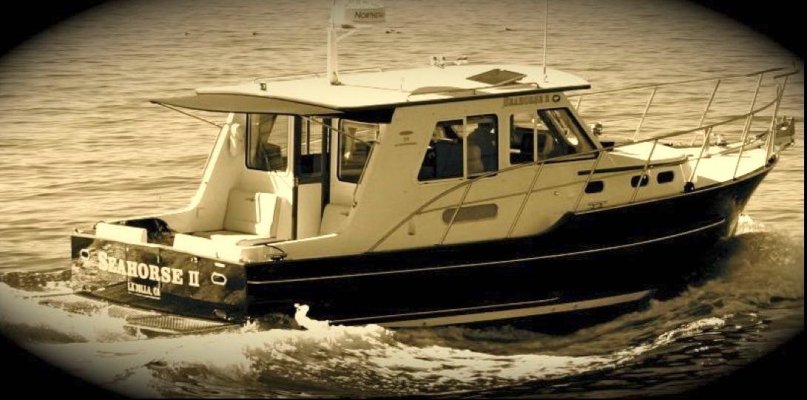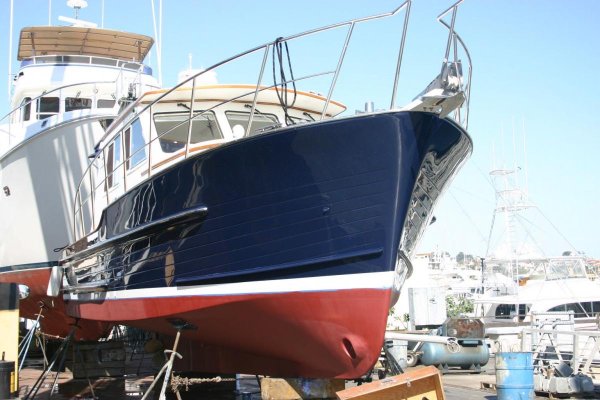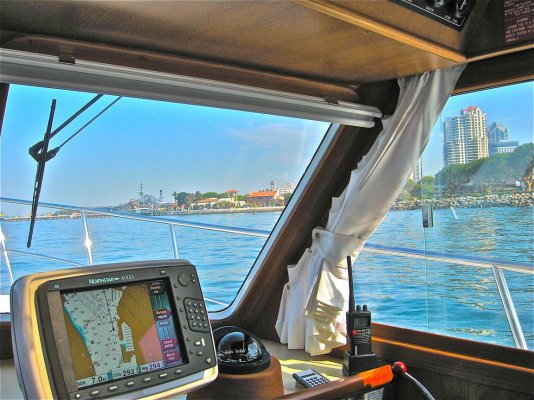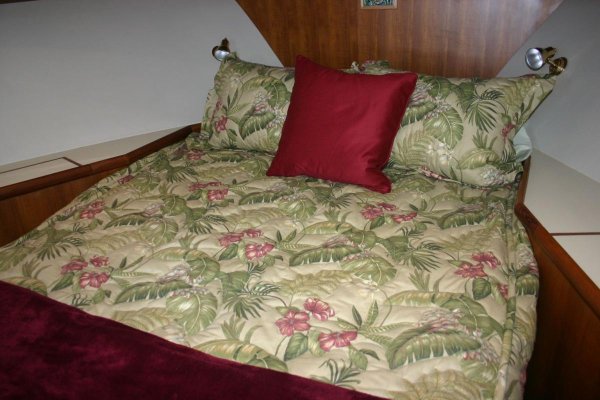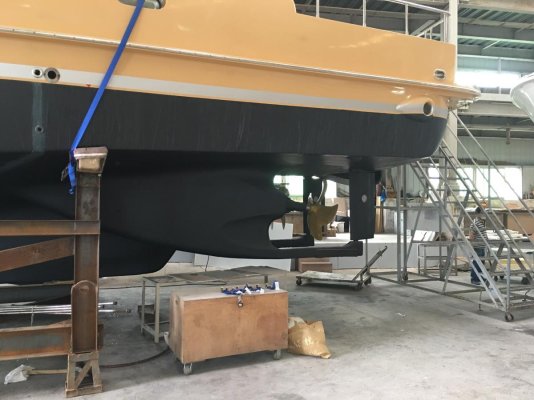You are using an out of date browser. It may not display this or other websites correctly.
You should upgrade or use an alternative browser.
You should upgrade or use an alternative browser.
Twin vs single
- Thread starter TwoToTango
- Start date
The friendliest place on the web for anyone who enjoys boating.
If you have answers, please help by responding to the unanswered posts.
If you have answers, please help by responding to the unanswered posts.
- Joined
- Nov 8, 2012
- Messages
- 2,315
- Location
- USA
- Vessel Name
- Sandpiper
- Vessel Make
- Bluewater 40 Pilothouse Trawler
We have twin FL 120s in our full displacement 40' trawler and see 3.5 GPH at 7.5 knots. Yes, great maneuverability and the "concept" of reliability but since most engine shutdowns are fuel related I'm not so convinced. Maintenance costs are X2 and actually doing the maintenance is a PITA with little access until you get up above 60' with proper engine rooms.
Our next vessel will be a single with a bow thruster. Protected prop, rudder shoe, etc.
Recently sea trialed a larger, heavier, full displacement vessel with a single screw that saw 2.5 GPH at 7.5 knots logged over a long passage. Not a huge difference in GPH but over a couple of thousand miles it adds up.
Sandpiper is the same boat as Airstreams. It has a single FL 120 instead of twins, protected prop, big rudder.
8 knot cruise at 1700 RPM burns around 1.8 to 1.9 GPH.
That's calculated every year from fuel purchase, dip stick fuel measurements and hour meter. It's a combination of idling, slow speed and cruising.
Last edited:
- Joined
- Nov 8, 2012
- Messages
- 2,315
- Location
- USA
- Vessel Name
- Sandpiper
- Vessel Make
- Bluewater 40 Pilothouse Trawler
I've had single engined trawlers for 34 years. Never had a breakdown requiring a tow.
Advantage for me having a single instead of twins:
With only one engone, I proactively replace or rebuild engine parts on a schedule instead of waiting for issues to develop. Transmissions cost less to rebuild when they still work.
I can devote more time to maintenance on just one.
More room to walk around.
Keel shoe protection for the prop and rudder.
Personal satisfaction when docking goes well.
Advantage for me having a single instead of twins:
With only one engone, I proactively replace or rebuild engine parts on a schedule instead of waiting for issues to develop. Transmissions cost less to rebuild when they still work.
I can devote more time to maintenance on just one.
More room to walk around.
Keel shoe protection for the prop and rudder.
Personal satisfaction when docking goes well.
"I've run my boat on one engine when the other engine died or the transmission died."
TTT, someone above mentioned the reliability of redundancy and I agree. Let me tell you why.
I was on the way back from Portland, OR coming up the Columbia. When we got to The Dalles where we were going to moor for the night. I stopped in the middle of the river and we set about putting out fenders and lines. I quickly realized that the stbd engine was still in gear. I ran up to the helm and the shifter was in neutral but we were still moving forward. The transmission was shot and stuck in gear.
Long story short, we ran the boat back to the yard where I'd had some work done (nothing to do with the trans). It was about a 95 mile trip done on the port engine alone.
Had I not had the second engine I'd have been screwed. There is no towing service on the Columbia, and no place anywhere closer than Portland that could work on the trans. I'd have had to hire a tug to tow me down to Portland and I can only imagine the cost of that.
I don't know where you do your boating but if you're stuck somewhere with a one engine boat and that engine craps out, you could be stuck there a long time.
TTT, someone above mentioned the reliability of redundancy and I agree. Let me tell you why.
I was on the way back from Portland, OR coming up the Columbia. When we got to The Dalles where we were going to moor for the night. I stopped in the middle of the river and we set about putting out fenders and lines. I quickly realized that the stbd engine was still in gear. I ran up to the helm and the shifter was in neutral but we were still moving forward. The transmission was shot and stuck in gear.
Long story short, we ran the boat back to the yard where I'd had some work done (nothing to do with the trans). It was about a 95 mile trip done on the port engine alone.
Had I not had the second engine I'd have been screwed. There is no towing service on the Columbia, and no place anywhere closer than Portland that could work on the trans. I'd have had to hire a tug to tow me down to Portland and I can only imagine the cost of that.
I don't know where you do your boating but if you're stuck somewhere with a one engine boat and that engine craps out, you could be stuck there a long time.
SteveK
Guru
- Joined
- Jul 5, 2019
- Messages
- 5,074
- Location
- Gulf Isalnds BC canada
- Vessel Name
- Sea Sanctuary
- Vessel Make
- Bayliner 4588
Know your boat.
Unless there was a 'V' in a reef that I threaded the keel into the props are protected as the forward part of the keel would hit first. Sure run aground and have the tide drop. lean over prop shaft damage. Sure run over a water logged object and it may take out one of the shafts. A lot must all conspire against you. But please stop saying props are unprotected suggesting imminent damage awaiting.
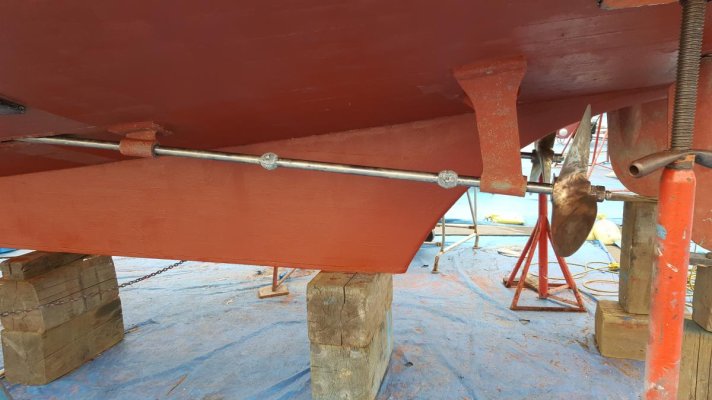
Unless there was a 'V' in a reef that I threaded the keel into the props are protected as the forward part of the keel would hit first. Sure run aground and have the tide drop. lean over prop shaft damage. Sure run over a water logged object and it may take out one of the shafts. A lot must all conspire against you. But please stop saying props are unprotected suggesting imminent damage awaiting.

What's a sailboat diesel?
What size is it?
My 25 foot Cape Dory 25D had a 7.5 hp, one cylinder Yanmar. Our 42 foot Catalina had a 40 hp, Yanmar four cylinder diesel (they later upgraded this to a 56 hp, turbocharged 4 cylinder halfway through production, as it was underpowered).
"I've run my boat on one engine when the other engine died or the transmission died."
TTT, someone above mentioned the reliability of redundancy and I agree. Let me tell you why.
...
I don't know where you do your boating but if you're stuck somewhere with a one engine boat and that engine craps out, you could be stuck there a long time.
I've only lost an engine one time (and when I realize how long I have been boating, that is pretty amazing), which was on my twin engine cruiser I had several years ago. At the time we were on the ICW, on the east coast of Florida, so although it was annoying, it was not a particularly perilous event.
But, yes, if you were halfway to Bimini on a single engine vessel, with no buddy boat, and you lost your only engine, it would not be particularly fun. Even worse, going through a reef pass, it could be catastrophic.
But, if you don't do stuff like that, I guess the risk is a whole lot less. Plus, I maintain my engines myself, mostly (grew up on a farm where we did the same for our diesel tractors). I have a lot of faith in my diesels.
Last edited:
rslifkin
Guru
- Joined
- Aug 20, 2019
- Messages
- 7,584
- Location
- USA
- Vessel Name
- Hour Glass
- Vessel Make
- Chris Craft 381 Catalina
Know your boat.
Unless there was a 'V' in a reef that I threaded the keel into the props are protected as the forward part of the keel would hit first. Sure run aground and have the tide drop. lean over prop shaft damage. Sure run over a water logged object and it may take out one of the shafts. A lot must all conspire against you. But please stop saying props are unprotected suggesting imminent damage awaiting.
View attachment 94547
This is a very good point. Pretty much all twins have the props more exposed than a single, however, many are not so exposed that they're all that easy to damage.
Even my planing hull has almost as much keel down there as what Soo-Valley shows. So yes, the props are more exposed than on a single and hitting a piece of debris or a rock could easily damage one, but if just nosing into a shallow area that doesn't have prop eating chunks of debris on the bottom, the hull will definitely hit before the props and rudders. And twins often do draw a bit less water.
Plus, we don't all explore areas right down to the draft of our boats. According to Chris Craft, I draw 3 feet. Everyone in the family has considered this boat to draw 3.5 feet as long as I've known, so I go by the more conservative number. I'll have to measure this winter... But anyway, if I see the depth get down to 6 feet, I'm nervous, going slow and watching the depth and surroundings like a hawk. If it dips under 5 feet, I'm not going further.
This isn't my boat in the picture, but another of the same (best hull shape picture I can find at the moment):

The biggest issue around here, when getting in too shallow water, is hitting old abandoned/lost chicken wire crab traps, that are often 1-1.5 feet high off the bottom. Getting those untangled from a prop is an adventure that a lot of my friends have had (I've been lucky so far). So, since we draw 4', I start getting nervous at anything under 6'.
sunchaser
Guru
- Joined
- Apr 9, 2008
- Messages
- 10,195
- Location
- usa
- Vessel Name
- sunchaser V
- Vessel Make
- DeFever 48 (sold)
We have twin FL 120s in our full displacement 40' trawler and see 3.5 GPH at 7.5 knots. Yes, great maneuverability and the "concept" of reliability but since most engine shutdowns are fuel related I'm not so convinced. Maintenance costs are X2 and actually doing the maintenance is a PITA with little access until you get up above 60' with proper engine rooms.
Our next vessel will be a single with a bow thruster. Protected prop, rudder shoe, etc.
Recently sea trialed a larger, heavier, full displacement vessel with a single screw that saw 2.5 GPH at 7.5 knots logged over a long passage. Not a huge difference in GPH but over a couple of thousand miles it adds up.
I wasn't aware that most larger vessel engine shutdowns were fuel related. Urban myth perpetuated? Maybe if you count running out of fuel, but that is a skipper problem.
But I do agree that if one wants to save fuel money a single engine KK is a good starting point, assuming your non fuel wallet is topped up.
Sailor of Fortune
Guru
Twins are very much more likely snag lobster or crab trap gear. floating debris is more of a hazard with twin screw as well.Know your boat.
Unless there was a 'V' in a reef that I threaded the keel into the props are protected as the forward part of the keel would hit first. Sure run aground and have the tide drop. lean over prop shaft damage. Sure run over a water logged object and it may take out one of the shafts. A lot must all conspire against you. But please stop saying props are unprotected suggesting imminent damage awaiting.
View attachment 94547
Twins are very much more likely snag lobster or crab trap gear. floating debris is more of a hazard with twin screw as well.
Around here, most crap traps are commercial (aside: I marvel that they are still fishing for crabs, as the commercials have put so much pressure on the local crab harvest that I haven't seen any sign of a Dungeness, any size or sex, in over 4 years) and are on a string of 10 traps. All of those strings end with a float, all of the lines are sinking lines, always aligned with the direction of the current (flood or ebb) which is also the direction of most frequent travel, so not much of a hazard. That said, occasional crabbers (pleasure boaters) frequenly ignorant of the niceties, will use floating lines, which in turn will align with the wind direction and float across the direction of travel, then they are a definite hazard for twins and less so, but still a hazard for singles.
I have been caught in this trap and had to put both in neutral and once proven that I had caught a line, immediately dive to unwind that line from my shaft.
Soo-Valley's photo of his GB shows way less keel than my deeper keeled C&L, and I suspect amongst the trawlers represented here, more are deeper than his than not.
ranger58sb
Guru
Were it me, and doing my as much of own maintenance as possible (as now), I'd lean toward single with thruster. Although some of that would be about access more so than cost.
Unlimited budget, twins, two thrusters, joy stick, etc.... and let somebody else deal with access issues. Probably not gonna happen, though...
I meant to add:
Number of engines if often a moot point. Once THE boat surfaces with all the other mandatory and nice-to-have features we want... the number of engines may well be a given, based on what's available in the marketplace.
-Chris
Codger2
Guru
- Joined
- Oct 11, 2007
- Messages
- 6,691
- Location
- US
- Vessel Name
- Circuit Breaker
- Vessel Make
- 2021..22' Duffy Cuddy cabin
Those were my exact thoughts about 12 years ago when I bought A Halvorsen 32' single (330B Cummins) SD hull with a bow thruster. Great boat, easy to maneuver, 8.4 knots at 2000rpm. I could put that boat anywhere a twin could go as she backed & filled terrifically and the bow thruster made the boat almost jump when activated. I cruised her 8 years and would probably still have her except with old age approaching, my wife wanted another couple on board to share her "sinking" fear with. That meant a bigger boat!Our next vessel will be a single with a bow thruster. Protected prop, rudder shoe, etc.
Here is probably the "best" boat I ever had!
Attachments
sunchaser
Guru
- Joined
- Apr 9, 2008
- Messages
- 10,195
- Location
- usa
- Vessel Name
- sunchaser V
- Vessel Make
- DeFever 48 (sold)
I meant to add:
Number of engines if often a moot point. Once THE boat surfaces with all the other mandatory and nice-to-have features we want... the number of engines may well be a given, based on what's available in the marketplace.
-Chris
On the never ending twins vs single threads, truer words were never spoken.
dhays
Guru
- Joined
- May 26, 2015
- Messages
- 9,045
- Location
- United States
- Vessel Name
- Kinship
- Vessel Make
- North Pacific 43
I'm surprised I haven't heard anyone mention that twins appear to have a shallower draft. I have no idea what I'm talking about - ask my wife - but when I look at KKs it appears twins give you about 11 less inches of draft. If you want to spend a lot of time in the Bahamas wouldn't that be a big benefit?
Seems to me if you are going to be running in skinny water, you would want the prop protection that a single provides.
dhays
Guru
- Joined
- May 26, 2015
- Messages
- 9,045
- Location
- United States
- Vessel Name
- Kinship
- Vessel Make
- North Pacific 43
Ok I know this is an age old debate- Twin engines vs Single. . I know most of the stated advantages and disadvantages like more maneuverability and back up power for twins. I get that . But given two identical boats w a full displacement hull., one with a single Lehman 120 and the other with twin 120s , how much extra fuel do the twins use at say cruising speed of around 6 nts? Twice? My gues is not that much more but does anyone have some real experience to answer that for me ? Also just how often really end up using the twin in a back up situation ? I’ve been told if one goes down the other is likely because it’s usually fuel issues that cause a diesel to stop . Thanks for your help . Just trying to educate myself. I like the idea of a single primarily because it’s easy on fuel. Done really have desire to go fast.
First, I have never owned a twin engine boat.
You have asked two questions; 1) How much fuel savings in a single vs twins? and 2) How often have folks experience an engine failure in one engine and used the second to get home?
1) I don’t think anyone is going to be able to give you a definitive answer simply because there are two many variables. Most everyone will agree that a single will be more efficient at displacement speeds vs twins. Most everyone will also agree that the cost of fuel is, for most of us, a small fraction of total cost of ownership. Twins are going to be more expensive than a single, but fuel is a tiny part of that.
2. While I have never used a twin engine as back up for an engine failure, you might also ask how many of those of us with singles have had an engine failure that left us stranded. In 30 years of operating single engine diesel boats, I have had that happen once. It was after a mechanic did some work on the engine. It ran just fine at the dock, but the first time we took the boat out the engine lost oil pressure. I was stranded and needed a tow. I also got a new engine out of the deal. If I’d had a twin, I would have been able to get home on my own power. Since it was a mistake by the mechanic that caused the problem, it would not have affected both engines in a twin configuration.
So, while I like single engine configurations, I think that if you are leaning towards a single in order to save fuel, you are looking at it wrong. The fuel savings aren’t enough to make a difference. If you like twins because of all their other advantages, you should simply go with twins.
Having said that, I would suggest shop the boat first and take the engine configuration that comes with that boat.
Nomad Willy
Guru
I've had single engined trawlers for 34 years. Never had a breakdown requiring a tow.
Advantage for me having a single instead of twins:
With only one engone, I proactively replace or rebuild engine parts on a schedule instead of waiting for issues to develop. Transmissions cost less to rebuild when they still work.
I can devote more time to maintenance on just one.
More room to walk around.
Keel shoe protection for the prop and rudder.
Personal satisfaction when docking goes well.
That was me before my engine quit SE of Hornby Is. in Georgia Strait.
I was lucky though. A bigger boat came by and towed us to Comox.
Sure there are advantages to singles but over all twins are better. They cost more and people pay the price. That alone is a very strong indication of “twins are better”. But when the boat gets old most everything changes as the owners go from wealthy to relatively poor.
Just like twins there are plenty of downsides to just one engine. Beyond the “elephant in the room”.
The biggest element of the singles v/s twins debate is MONEY.
But this issue is so evenly divided that one could say it’s obvious it really dosn’t matter. But when your engine quits out in big water .... it matters.
Last edited:
Comodave
Moderator Emeritus
- Joined
- Jul 2, 2015
- Messages
- 21,284
- Location
- Au Gres, MI
- Vessel Name
- Black Dog
- Vessel Make
- Formula 41PC
As to twins and prop protection, when we brought our current boat home from Virginia as we went up the Hudson the river had countless debris in it. Some was on the surface and a lot was submerged. We hit submerged objects probably 15 or more times. We could feel the boat shudder all the way up on the flybridge. I was sure that our props were toast. But when we got home and hauled the boat for the winter there was no damage to the props. Our keel does project below the props so I guess it did a great job of protecting the props. Now we did have a vibration that was due to the many many coats of paint that the PO had put on the props. I pulled the props and had them scanned. They paint was so thick that they had to sand blast the paint off before they could scan them. When the scanned them one blade on each was way out of pitch so they rebuilt the props. Now there is no vibration.
timb7734
Senior Member
- Joined
- May 8, 2012
- Messages
- 197
- Location
- USA
- Vessel Name
- Terrapin
- Vessel Make
- Florida Bay Coaster 42'
Single vs Twins
I have owned singles with and without bow thrusters, and many twins, two of the last three were trawlers with twins and thruster.
The extra maintenance and fuel is a non starter argument in the face of all other boating expenses, partially as with twins the engines can be much smaller, vis a vis 70 hp versus 120+ hp. Further the smaller engines get smaller props, thus shallow draft, skeg protection and the ability to sit the boat flat on the bottom at low tide for cosmetic or mechanical issues on the hull.
These boats drafted 3' and 4' respectively which was/is ideal for South Florida and the North Channel of Lake Huron as well as the whole of the
Great Lakes cruising grounds.
I have owned singles with and without bow thrusters, and many twins, two of the last three were trawlers with twins and thruster.
The extra maintenance and fuel is a non starter argument in the face of all other boating expenses, partially as with twins the engines can be much smaller, vis a vis 70 hp versus 120+ hp. Further the smaller engines get smaller props, thus shallow draft, skeg protection and the ability to sit the boat flat on the bottom at low tide for cosmetic or mechanical issues on the hull.
These boats drafted 3' and 4' respectively which was/is ideal for South Florida and the North Channel of Lake Huron as well as the whole of the
Great Lakes cruising grounds.
Ski in NC
Technical Guru
This has been discussed soooo often. Most every thing covered to some degree.
I will emphasize one bit:
If you get twins, make dang sure you can get to every part of both engines. So many twin engine boats in the 35/40/45' range the engines are a tight fit, especially on the outboard side. Some boats the outboard sides are basically impossible to access. Do not buy one of those.
A local friend and his family has bought two twin engine boats in the last several years. Both quite well used. I looked at both before they bought them, and said this thing will be a problem as a good bit of the engines are hidden, and there is stuff you need to get to there. They bought them anyway. And sure enough, they had a few engine problems that caused major trips to be aborted. Yes, they had one functional engine to get them home, but the trip was shot as it was over a week at a distant dock dealing with mechanics.
With good access to the engine (and some twin boats have good access too), the engine can be thoroughly checked out and little things dealt with before they become big things. Yes, if the single fails, you stop and will need a tow. But a well tended diesel is very reliable and this will be rare.
And owners of singles tend to consider their engine a bit sacred and take better care of it than the ones that own twins. At least some are that way, like my friend above. In his case, two somewhat neglected engines caused way more trouble than my well tended single.
Of course I probably jinxed my engine!!!
I will emphasize one bit:
If you get twins, make dang sure you can get to every part of both engines. So many twin engine boats in the 35/40/45' range the engines are a tight fit, especially on the outboard side. Some boats the outboard sides are basically impossible to access. Do not buy one of those.
A local friend and his family has bought two twin engine boats in the last several years. Both quite well used. I looked at both before they bought them, and said this thing will be a problem as a good bit of the engines are hidden, and there is stuff you need to get to there. They bought them anyway. And sure enough, they had a few engine problems that caused major trips to be aborted. Yes, they had one functional engine to get them home, but the trip was shot as it was over a week at a distant dock dealing with mechanics.
With good access to the engine (and some twin boats have good access too), the engine can be thoroughly checked out and little things dealt with before they become big things. Yes, if the single fails, you stop and will need a tow. But a well tended diesel is very reliable and this will be rare.
And owners of singles tend to consider their engine a bit sacred and take better care of it than the ones that own twins. At least some are that way, like my friend above. In his case, two somewhat neglected engines caused way more trouble than my well tended single.
Of course I probably jinxed my engine!!!
TwoToTango
Member
Thank you . Lots to consider and do appreciate your input!
- Joined
- Nov 8, 2012
- Messages
- 2,315
- Location
- USA
- Vessel Name
- Sandpiper
- Vessel Make
- Bluewater 40 Pilothouse Trawler
In the PNW hitting logs and other pieces of wood is the danger.
A single protected prop has a better chance of survival.
We ran over a submerged log once and had no damage except scuffed up bottom paint. If we had twins, we would have lost at least one prop.
A single protected prop has a better chance of survival.
We ran over a submerged log once and had no damage except scuffed up bottom paint. If we had twins, we would have lost at least one prop.
rsn48
Guru
- Joined
- Feb 18, 2019
- Messages
- 2,019
- Location
- Canada
- Vessel Name
- Capricorn
- Vessel Make
- Mariner 30 - Sedan Cruiser 1969
My thoughts:
1. Fuel economy is very similar when going at displacement hull speeds on a semi displacement hull boat capable of speeds in the "planing" zone. Take a Back Cove 33 with a 400 + diesel engine. At planing speeds, yes the boat is going to eat fuel, no surprises there. But cruising at 7 knots, the fuel consumption will be miserly and your fuel tank capacity at reduced cruising speeds will allow you decent distances.
2. I see you are in Anacortes so I am assuming you are quite familiar with conditions in the Strait of Georgia (Salish Sea), Juan de Fuca Strait, etc. Conditions can be benign, almost glass flat but they can be quite "slammy" in a boat, safe but not the most comfortable ride.
I was with a buddy in his Back Cove 33 bringing his boat back from the Vancouver Wooden Boat Show a week before this last Labour Day weekend. The Strait of Georgia was slammy. We could have chosen to go at 7 knots and taken roughly 7 hours to get to Nanaimo but instead for the first half hour our cruising speed was 23 knots, then for the remainder 16 knots, it took us 3 hours.
We went faster for a couple of reasons. First often going through crappy water faster is actually more comfortable, though slammy, than going slower and bouncing all over the place. Secondly we left around 9:30 AM and didn't want to be out in the water when the winds were being predicted to increase in the latter part of the afternoon. We were in 20 knot winds and the predictions were for 25 gusting to 30 + knots later in the day.
3) If you haven't done a lot of boating, I would suggest keeping an open mind to boat speed, particularly in my and your areas as being able to make quick jumps can be more pleasant and safer. You can always slow down, but depending on the boat, you can't always speed up. Go slow and you use fuel slowly.
4) Twins are great to have but you pay more for twins logically and so the fuel savings comes nothing near what you would have saved by getting a single engine for both initial purchase and servicing.
5) I am assuming you are going to purchase a used boat. Depending on how old it is, if you have to face repowering I can personally tell you it can be very expensive. I just finally had my new Merc gas I/O engine and leg installed to completion last week. If you are replacing like to like, basically same engine, it isn't as brutally expensive as have to replace everything, re-glass the transom for a new hole, and make adjustments to the interior for various reasons. I could have bought a new BMW 3 series car for what I shelled out, and that was for gas and a single engine. Now think of repowering twin diesels. Even rebuilds can get pricey, particularly with twins.
6) Pay almost as much attention to hull design as you are to twins or not. In those sea conditions I described from Vancouver to Nanaimo, a number of trawler designs, particularly older ones would have been very uncomfortable in the conditions we travelled through. Some of the older designs with almost rounded bottoms aren't the best hulls for our Straits in windy conditions.
There is a reason some don't like a flying bridge, the side wind profile with the extra structure on top can add to the "sail" effect of side winds in an unpleasant wind condition.
PS: C Tow is available for $200 Canadian, roughly $140 American for their "Admirable" package which covers from Northern Vancouver Island and includes all of Washington state, obviously reciprocal agreements with american pleasure boat tow companies.
From their web site:
Our premiere, unlimited membership includes all of our services, and:
»Unlimited tows to the nearest port of repair
»Unlimited service calls
»Extended coverage to northern Vancouver Island and south throughout Washington State
1. Fuel economy is very similar when going at displacement hull speeds on a semi displacement hull boat capable of speeds in the "planing" zone. Take a Back Cove 33 with a 400 + diesel engine. At planing speeds, yes the boat is going to eat fuel, no surprises there. But cruising at 7 knots, the fuel consumption will be miserly and your fuel tank capacity at reduced cruising speeds will allow you decent distances.
2. I see you are in Anacortes so I am assuming you are quite familiar with conditions in the Strait of Georgia (Salish Sea), Juan de Fuca Strait, etc. Conditions can be benign, almost glass flat but they can be quite "slammy" in a boat, safe but not the most comfortable ride.
I was with a buddy in his Back Cove 33 bringing his boat back from the Vancouver Wooden Boat Show a week before this last Labour Day weekend. The Strait of Georgia was slammy. We could have chosen to go at 7 knots and taken roughly 7 hours to get to Nanaimo but instead for the first half hour our cruising speed was 23 knots, then for the remainder 16 knots, it took us 3 hours.
We went faster for a couple of reasons. First often going through crappy water faster is actually more comfortable, though slammy, than going slower and bouncing all over the place. Secondly we left around 9:30 AM and didn't want to be out in the water when the winds were being predicted to increase in the latter part of the afternoon. We were in 20 knot winds and the predictions were for 25 gusting to 30 + knots later in the day.
3) If you haven't done a lot of boating, I would suggest keeping an open mind to boat speed, particularly in my and your areas as being able to make quick jumps can be more pleasant and safer. You can always slow down, but depending on the boat, you can't always speed up. Go slow and you use fuel slowly.
4) Twins are great to have but you pay more for twins logically and so the fuel savings comes nothing near what you would have saved by getting a single engine for both initial purchase and servicing.
5) I am assuming you are going to purchase a used boat. Depending on how old it is, if you have to face repowering I can personally tell you it can be very expensive. I just finally had my new Merc gas I/O engine and leg installed to completion last week. If you are replacing like to like, basically same engine, it isn't as brutally expensive as have to replace everything, re-glass the transom for a new hole, and make adjustments to the interior for various reasons. I could have bought a new BMW 3 series car for what I shelled out, and that was for gas and a single engine. Now think of repowering twin diesels. Even rebuilds can get pricey, particularly with twins.
6) Pay almost as much attention to hull design as you are to twins or not. In those sea conditions I described from Vancouver to Nanaimo, a number of trawler designs, particularly older ones would have been very uncomfortable in the conditions we travelled through. Some of the older designs with almost rounded bottoms aren't the best hulls for our Straits in windy conditions.
There is a reason some don't like a flying bridge, the side wind profile with the extra structure on top can add to the "sail" effect of side winds in an unpleasant wind condition.
PS: C Tow is available for $200 Canadian, roughly $140 American for their "Admirable" package which covers from Northern Vancouver Island and includes all of Washington state, obviously reciprocal agreements with american pleasure boat tow companies.
From their web site:
Our premiere, unlimited membership includes all of our services, and:
»Unlimited tows to the nearest port of repair
»Unlimited service calls
»Extended coverage to northern Vancouver Island and south throughout Washington State
Last edited:
Nomad Willy
Guru
In the PNW hitting logs and other pieces of wood is the danger.
A single protected prop has a better chance of survival.
We ran over a submerged log once and had no damage except scuffed up bottom paint. If we had twins, we would have lost at least one prop.
We did too, in Clearance Strait.
The sound was scary. BOOOM. Like a bomb not too far away. Also no damage and we’re single screw w bronze shoe.
We saw the log astern. About 15” in dia. And 10’ long. Hard to imagine a twin getting by w/o damage.
Last edited:
Wayfarer
Guru
- Joined
- Aug 29, 2014
- Messages
- 2,228
- Location
- USA
- Vessel Name
- Sylphide
- Vessel Make
- Kingston Aluminum Yacht 44' Custom
I hit several submerged objects on the west end of the Erie Canal, and never once saw any of them. Scared the bejesus out of me every time. I was very thankful to have running gear protected by the keel and a shoe, and was also very glad to have a tough metal hull.
markpierce
Master and Commander
- Joined
- Sep 25, 2010
- Messages
- 12,557
- Location
- USA
- Vessel Name
- Carquinez Coot
- Vessel Make
- penultimate Seahorse Marine Coot hull #6
My two boating friends, having twin engines/struts/propellers, have damaged same. Am still single, and no damaged running gear, yet.
jimdavi
Senior Member
- Joined
- Aug 18, 2014
- Messages
- 466
- Location
- USA
- Vessel Name
- Couple’s Retreat
- Vessel Make
- 2019 North Pacific 45
Had twins and singles. Never had an engine failure but have damaged props in the river with twins. When we chose the NP 45, the decision was like most, a compromise. As I get older, not in so much of a hurry. I used to want 100 buttons on the stereo, now want 1. I wanted simple and accessible engine for most maintenance tasks. 8-11 knots is fine for us as we’re at this time more about the journey. Go drive both, look at access and the boat for you will become an easier decision based on what You want. Good luck as this discussion will go on longer that “contract signed” world record post!
CaptainSEA
Veteran Member
Go for the Gusto... Go With Twins!
If you want to get good mileage with twins... shut one down and go really slow [like 4.5 to 5.5knots]. Make sure the idle trany can freewheel without damage. If not; lock the shaft on idle engine.
Best plus I see about a single is full keel with skeg and attached rudder for grounding protection and general prop protection.
Our 34' Tolly twin gasser fully loaded is 21K lbs +/-
1 - 4.5 to 5.5 knots on one engine = just under 3 nmpg
2 - 6.5 to 7 knots on twins [7.58 knots is calced hull speed] = 2 nmpg
3 - 16 to 17 knots [on full plain] = 1 nmpg
4 - 22 to 23 knots at WOT = OMG nmpg!!
When we are in no rush [which is normally the case] slower speeds with reduced fuel usage [#'s 1 and 2] are our preference.
When we have desire to get there more than twice as quick... #3 works well.
#4, WOT works well for testing the drivetrain and for occasional, unusual need to really quickly alter specific location on the water. I never have it at WOT for more than a minute or three.
I do really like the many speed levels as well as hard chine handling capabilities when on full-plain and hard chine stability while at anchor that exists with planing hull and twins.
Also, 2'10" draft works well. Having twin props it is really important to keep close eye on depth sounder when in shallow waters. As well, keeping an eye out for debris while cruising is another requirement.
If you want to get good mileage with twins... shut one down and go really slow [like 4.5 to 5.5knots]. Make sure the idle trany can freewheel without damage. If not; lock the shaft on idle engine.
Best plus I see about a single is full keel with skeg and attached rudder for grounding protection and general prop protection.
Our 34' Tolly twin gasser fully loaded is 21K lbs +/-
1 - 4.5 to 5.5 knots on one engine = just under 3 nmpg
2 - 6.5 to 7 knots on twins [7.58 knots is calced hull speed] = 2 nmpg
3 - 16 to 17 knots [on full plain] = 1 nmpg
4 - 22 to 23 knots at WOT = OMG nmpg!!
When we are in no rush [which is normally the case] slower speeds with reduced fuel usage [#'s 1 and 2] are our preference.
When we have desire to get there more than twice as quick... #3 works well.
#4, WOT works well for testing the drivetrain and for occasional, unusual need to really quickly alter specific location on the water. I never have it at WOT for more than a minute or three.

I do really like the many speed levels as well as hard chine handling capabilities when on full-plain and hard chine stability while at anchor that exists with planing hull and twins.
Also, 2'10" draft works well. Having twin props it is really important to keep close eye on depth sounder when in shallow waters. As well, keeping an eye out for debris while cruising is another requirement.

Last edited:
Similar threads
- Replies
- 18
- Views
- 1K

